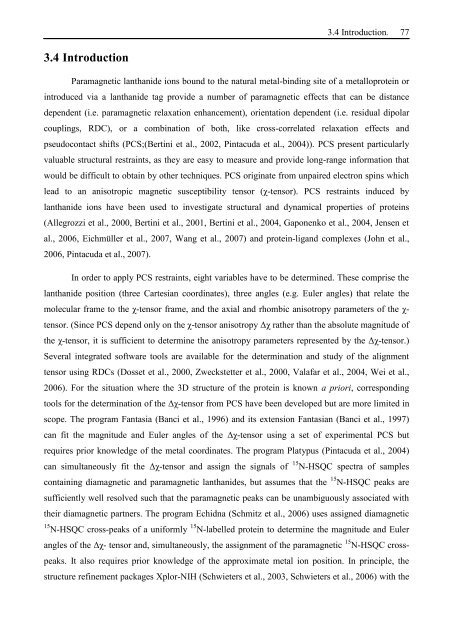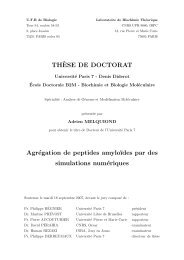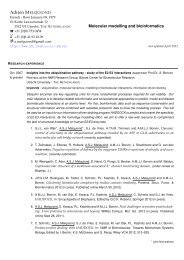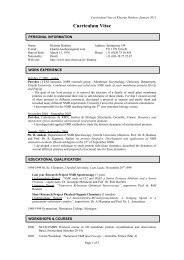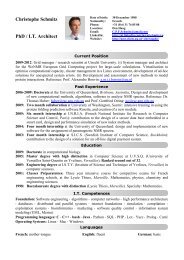Thesis Title: Subtitle - NMR Spectroscopy Research Group
Thesis Title: Subtitle - NMR Spectroscopy Research Group
Thesis Title: Subtitle - NMR Spectroscopy Research Group
Create successful ePaper yourself
Turn your PDF publications into a flip-book with our unique Google optimized e-Paper software.
3.4 Introduction<br />
3.4 Introduction. 77<br />
Paramagnetic lanthanide ions bound to the natural metal-binding site of a metalloprotein or<br />
introduced via a lanthanide tag provide a number of paramagnetic effects that can be distance<br />
dependent (i.e. paramagnetic relaxation enhancement), orientation dependent (i.e. residual dipolar<br />
couplings, RDC), or a combination of both, like cross-correlated relaxation effects and<br />
pseudocontact shifts (PCS;(Bertini et al., 2002, Pintacuda et al., 2004)). PCS present particularly<br />
valuable structural restraints, as they are easy to measure and provide long-range information that<br />
would be difficult to obtain by other techniques. PCS originate from unpaired electron spins which<br />
lead to an anisotropic magnetic susceptibility tensor (χ-tensor). PCS restraints induced by<br />
lanthanide ions have been used to investigate structural and dynamical properties of proteins<br />
(Allegrozzi et al., 2000, Bertini et al., 2001, Bertini et al., 2004, Gaponenko et al., 2004, Jensen et<br />
al., 2006, Eichmüller et al., 2007, Wang et al., 2007) and protein-ligand complexes (John et al.,<br />
2006, Pintacuda et al., 2007).<br />
In order to apply PCS restraints, eight variables have to be determined. These comprise the<br />
lanthanide position (three Cartesian coordinates), three angles (e.g. Euler angles) that relate the<br />
molecular frame to the χ-tensor frame, and the axial and rhombic anisotropy parameters of the χ-<br />
tensor. (Since PCS depend only on the χ-tensor anisotropy Δχ rather than the absolute magnitude of<br />
the χ-tensor, it is sufficient to determine the anisotropy parameters represented by the Δχ-tensor.)<br />
Several integrated software tools are available for the determination and study of the alignment<br />
tensor using RDCs (Dosset et al., 2000, Zweckstetter et al., 2000, Valafar et al., 2004, Wei et al.,<br />
2006). For the situation where the 3D structure of the protein is known a priori, corresponding<br />
tools for the determination of the Δχ-tensor from PCS have been developed but are more limited in<br />
scope. The program Fantasia (Banci et al., 1996) and its extension Fantasian (Banci et al., 1997)<br />
can fit the magnitude and Euler angles of the Δχ-tensor using a set of experimental PCS but<br />
requires prior knowledge of the metal coordinates. The program Platypus (Pintacuda et al., 2004)<br />
can simultaneously fit the Δχ-tensor and assign the signals of 15 N-HSQC spectra of samples<br />
containing diamagnetic and paramagnetic lanthanides, but assumes that the 15 N-HSQC peaks are<br />
sufficiently well resolved such that the paramagnetic peaks can be unambiguously associated with<br />
their diamagnetic partners. The program Echidna (Schmitz et al., 2006) uses assigned diamagnetic<br />
15 N-HSQC cross-peaks of a uniformly 15 N-labelled protein to determine the magnitude and Euler<br />
angles of the Δχ- tensor and, simultaneously, the assignment of the paramagnetic 15 N-HSQC cross-<br />
peaks. It also requires prior knowledge of the approximate metal ion position. In principle, the<br />
structure refinement packages Xplor-NIH (Schwieters et al., 2003, Schwieters et al., 2006) with the


